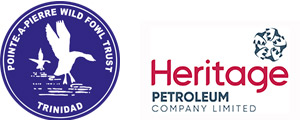International experts Dr Joanna Ostapkowicz, Curator of the Liverpool Museum and Dr Fiona Brock, Post Doctoral Chemist, Radio-Carbon Lab, Oxford University recently visited the Pointe-a-Pierre Wildfowl Trust to research and to obtain samples from the wood pieces found in the Trust’s exhibit of First People’s artefacts for carbon-dating. The wood pieces form part of the Peter Harris Collection.
In 1987 Harris opened the exhibit of his permanent loan of Amerindian artefacts to the Trust providing an opportunity for people to reach into the past and familiarise themselves with the experience of the First Peoples.
The collection, which was catalogued with help from Harris’ wife, Marion, and some colleagues of the Trinidad and Tobago Historical Society, forms an integral part of the Trust’s work with linkages and with its environmental education and public awareness programmes.
Harris, an archaeology graduate of University of Florida, Gainesville, as his second career, was also Senior Fellow, Academy of Arts, Letters, Culture and Public Affairs, University of Trinidad and Tobago (UTT). He presented his seminal report on Banwari Trace (Banwari Man) and collaborated extensively with Dr Arie Boomert of Leiden University, Netherlands. Before his death in May 2013, Harris was working on determining the origin of the bones discovered during the restoration of the Red House. His son, Chris Harris continues to take interest in his father’s archaeological work in Trinidad and Tobago.
Dr Joanna Ostapkowicz, Curator, Americas collections, National Museums, Liverpool, an authority on Pre-Hispanic Caribbean Sculptural Arts and who has worked with wood identification, 3D scanning of the Shroud of Turin; the Barrios Reliquary, amongst other interests, collaborated with Dr Fiona Brock, Radiocarbon Laboratory Post Doctoral Chemist, Research Laboratory for Archaeology and the History of Art, Oxford University, on “Birdmen” dating of Pre-Hispanic Caribbean wood sculptures in the British Museum. Dr Brock has worked on the radiocarbon dating of historical parchments and other artefacts in Egypt, Japan, Siberia, Canada, Alaska & Utah; she has worked in the famed Chauvet-Pont-Arc Cave, Ardeche, France (pre-historic cave paintings of wild animals) and with wood pre-treatment protocols and measurement of tree-ring standards and the Oxford Radiocarbon Accelerator Unit (ORAU) (www.arch.ox.ac.uk/FB1).
Together they visited the Pointe-a-Pierre Wildfowl Trust’s Peter Harris Permanent Loan Collection to secure scrapings of the wood artefacts for carbon dating research. Some of these samples are being shared with their colleagues of the Max Planck Institute, Leipzig, Germany, a world renowned leader in the field, as well as with the USDA Forestry Service.
The artefacts were found in the Pitch Lake, La Brea by Harris and his colleagues of the South section of the Trinidad and Tobago Historical Society.


